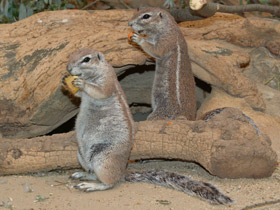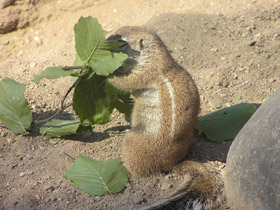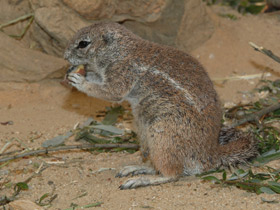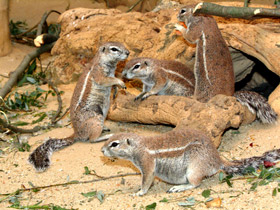The Cape ground squirrel Xerus inauris
Cape ground squirrel видео
The Cape ground squirrel is native to south-western areas of Africa. The Cape ground squirrel resembles the red squirrel but the ground squirrel lives in the burrow rather than in trees. The Cape ground squirrel has black skin with a short, coarse coat without underfur. The body length of this cute rodent ranges from 22 to 26 cm, and the length of the tail is almost the same (22-25 cm). Cape ground squirrels inhabit savannas, light forests, deserts, and semi-deserts.
Xerus inauris is the only African squirrel that builds a branched system of burrows inhabited by one to three families. Cape ground squirrels eat grasses, herbs, seeds, and shrubs. They also dig up edible roots and bulbs. Ground squirrels can do serious damage to some crops including groundnut, sweet potato, etc. These squirrels often consume locusts and other insects, and sometimes destroy bird nests or catch small lizards.
The behaviour of Cape ground squirrels is similar to that of marmots but ground squirrels do not hibernate. Breeding in the populations of X. inauris takes place all year but each adult female produces only one litter per year. The peak of births occurs in winter and spring months (June and September-October). Each litter consists of only 1 to 3 offspring, with average litter size 1.9. Young ground squirrels disperse during their second year of life.
Cape ground squirrels congregate in groups of 2 to 14 animals. Each group occupies a certain burrow system that may have up to 100 exits. The burrows belonging to neighbouring groups are not connected. Stable bands of Cape ground squirrels consist of up to four adult females and their offspring. Adult males do not have permanent associations with a certain female group and widely move across the whole territory occupied by Cape ground squirrels. Nursing females usually are aggressive towards males and peaceful interactions between different sexes can be seen only during mating period when the male is tolerated by the female and is allowed to stay within her home territory for a few weeks, sharing this area with the female and her offspring born in the last year. Non-aggressive interactions in the Cape ground squirrel groups, such as grooming, have been observed in both adult and young animals. Adult male can be socially groomed by females or subadult animals.
The area surrounding main burrow occupied by the group members (the “core” of the home range) is most actively guarded by the dominant female. Other adult females also participate in the protection of the home range but their contribution is less significant. The births given by the females of the same group are synchronized (the time difference does not exceed several days). In this period, subadult animals stay with their families but later they start dispersing. Although the relationships between adult females and one-year-old animals are still peaceful, adult females spend larger proportion of time with their new offspring. Alien individuals often visit home ranges of the stable groups to explore their burrows but resident females drive them away. While chasing the intruders, dominant female may find herself within other group’s territory; in such a case, she in turn will be chased away by the “hosts” of the territory.
Study in Namibia focused on the study area of 14 ha has shown that stable female groups consisted of 1-3 adult females and up to 9 subadult females, with all animals being related to each other. Subadult (one year old) males generally dispersed far away from their natal home ranges. The males were also found to congregate in all-male gangs numbering up to 19 animals. Large gangs are subdivided into sub-groups of 4 to 5 males and group members are changing daily. These all-male groups roam large home ranges that overlap those of multiple female groups. All-male groups sustain for at least one year. When no female is in oestrus, males sleep in vacant burrow clusters away from female groups. Interactions between the males in the band are amicable, but consist of a linear dominance hierarchy. Dominant males generally belong to the older age category (over three years old), while ages of subordinate males vary from 8 months to 3 years. Observations show that Cape ground squirrel males do not defend their home territory and do not compete for the access to females (at least, the rate of aggression is very low).



















































